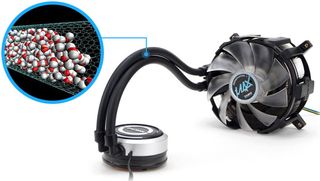Zalman Announces Reserator 3 Liquid Cooler with Nanofluids
Zalman's Reserator 3 Max cooler is finally official.
Zalman this month launched its new Reserator 3 Max cooler. Zalman is calling the Reserator 3 Max the world's first nanofluids applied cooler and the cooler actually won an award earlier this year at CES 2013.

The Reserator 3 is a closed-loop liquid cooler hybrid that combines the reliability and low maintenance of a traditional cooler and the quietness and performance of a liquid cooler. It provides up to 400W of ultra silent cooling utilizing a 120-mm blue LED fan, a dual radial radiator and a high efficient water pump.
The water block and enclosed pump measures 65 x 65 x 32(H)-mm and the radiator measures 154(L) x 120(W) x 32(H)-mm. The fan itself is 120 x 120 x 25(H)-mm and comprises of black pearl nickel-plated aluminum. Other features include Multiple-heatpipe Pressing Joints (MPJ) that secures and maximizes long distance heat transfer, and minimizes thermal resistance. It's compatible with most desktop CPU sockets and can be fitted into a middle tower case with a width of 180-mm.
Though Zalman's been teasing this one since January, Zalman has yet to offer information on pricing or a release date.
Stay on the Cutting Edge
Join the experts who read Tom's Hardware for the inside track on enthusiast PC tech news — and have for over 25 years. We'll send breaking news and in-depth reviews of CPUs, GPUs, AI, maker hardware and more straight to your inbox.
-
digiex "Zalman with its unique technology came up with the world first nanofluids refrigerant applied cooler to maximize the cooling performance.Reply
· Using nanofluids coolant improves thermal conductivity by mixing nanoparticles with fluids."
What element that nano particles would be? -
outlw6669 I am quite sceptical of their 400W claim.Reply
There is really not much surface area with which to dissipate so much heat. -
digiex http://www.zalman.co.kr/global/product/Product_Read.php?Idx=824Reply
I wonder what is the composition of the nanoparticle added to the cooling fluid? -
SvRommelvS Is the fan built in? That would be a nifty way for this thing to further differenciate itself from the current crop of closed-loop liquid coolerReply -
gm0n3y I'd like to learn more about the thermal performance advantage of adding the nano-particles to the fluid. I've been following the research over the years and there is still (as far as I know) no definitive proof that nano-particles are able to lower temperatures. Some researchers have found improvements but others have not been able to duplicate their work. If Zalman has somehow made a breakthrough here I think I would have read about it in one of the science journals. They are probably just throwing in one of the more commonly studied compounds so they can market it as such, but I hope I'm wrong.Reply -
fkr https://www.google.com/search?client=opera&q=nanoparticles+coolimg&sourceid=opera&ie=utf-8&oe=utf-8&channel=suggest#bav=on.2,or.r_cp.r_qf.&channel=suggest&ei=9BYNUoXNBIa32wWM9YHQBg&fp=114bb3f9fc3d34c7&q=nanoparticles+cooling&sa=X&spell=1&ved=0CCoQvwUoAAReply
maybe they are using aluminum -
Narcissistic_Martyr ReplyI wonder what is the composition of the nanoparticle added to the cooling fluid?
Based on the current literature on computer cooling with relatively inexpensive materials if I had to guess they are probably using alumina nanoparticles in a mixture of water, ethylene glycol, and glycerol. Although, if the particles in the diagram aren't water then SiO2 or TiO2 look like the most likely candidates. Easier to stabilize too IMO.
If anyone wants to, you can actually mix up a batch of nanoparticle heat transfer fluid at home if you've got a roller mill with 50 micron zirconia beads, some Al2O3 nanoparticles, distilled water, and ethylene gylcol in a 1 vol% Al2O3 dispersion in 3:1 H2O:EG base solution (please don't drink the ethylene glycol or get the nanoparticles on your skin they cause cancer).
Granted without electrostatic stabilization the alumina suspension won't be stable for months at a time but it should be good for a few days if you want to benchmark with it. If you don't have access to those materials the start up costs would run $200-1000 depending on how good you are at fabricating equipment. On the plus side a fluid like that can shave 4-5C off your temps depending on your setup.
Most Popular



